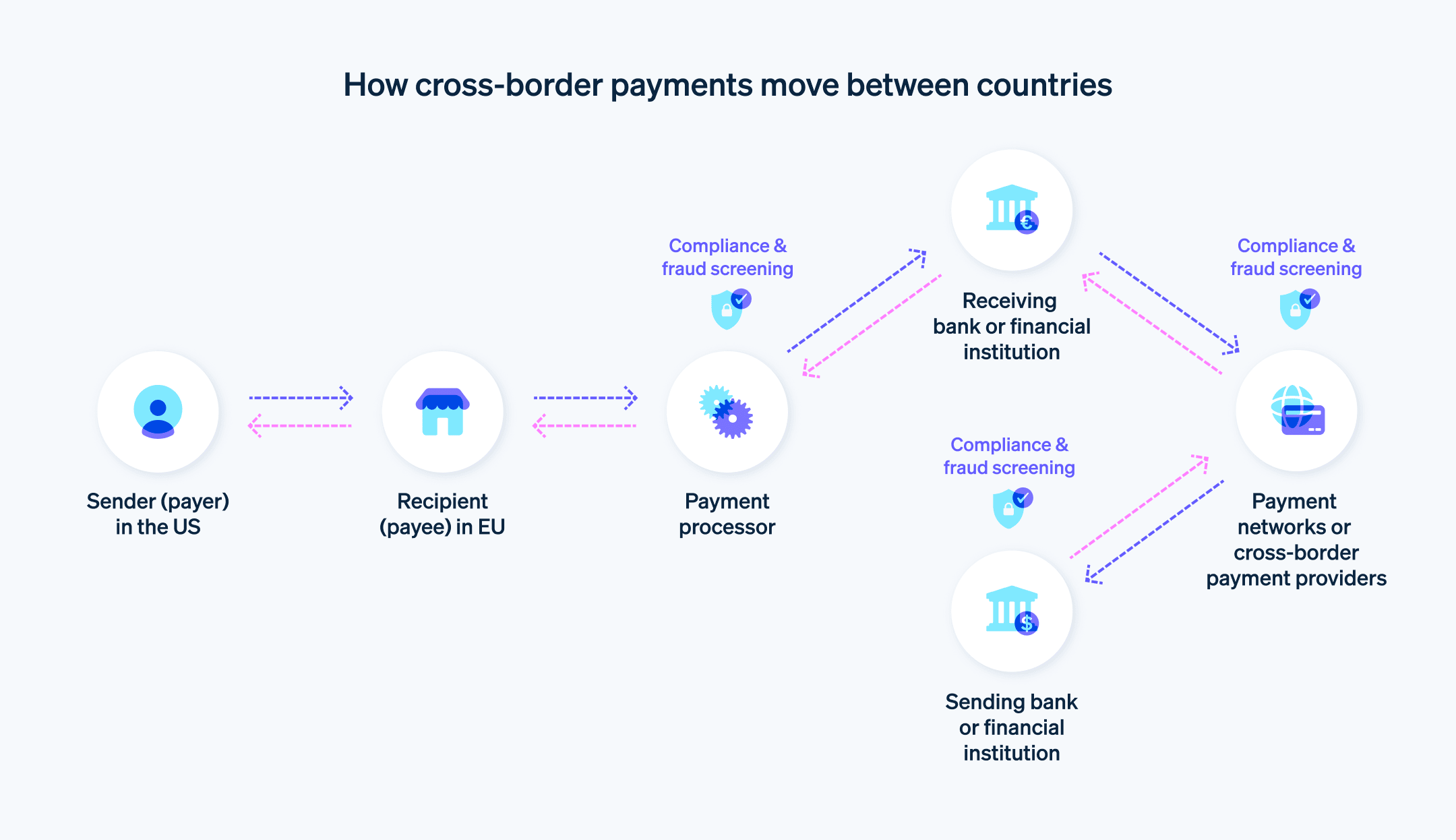随着全球市场的不断扩大,越来越多的企业正在利用跨境贸易机会。2022 年,客户向企业支付了约 2.8 万亿美元的跨境款项,而同年 B2B 跨境支付金额超过了 150 万亿美元。然而,进行跨境收付账款可能是一个复杂且具有挑战性的过程,需要应对各种监管要求、费用以及风险。
尽管存在这些挑战,但对于希望开拓新市场、接触新客户并实现收入来源多样化的企业来说,跨境支付至关重要。而且针对这些挑战是有解决办法的。通过正确的支付方式和策略,企业可以降低成本、改善现金流并加速增长。
下面,我们将探讨现有的各类跨境支付方式、跨境支付对企业的好处与弊端,以及进行跨境收付账款的流程。无论您是成熟的企业还是处于成长阶段的初创企业,了解和规划跨境支付对于保持竞争力和保持您的财务运作尽可能高效和有效至关重要。
本文内容
- 什么是跨境支付?
- 跨境支付方式
- 跨境支付的用途是什么?
- 跨境支付的优缺点
- 如何进行跨境支付
- 使用 Stripe 进行跨境支付
什么是跨境支付?
跨境支付是位于不同国家的各方之间发生的金融交易。这些支付涉及将资金或资产从一个国家转移到另一个国家,通常是通过银行或其他金融机构进行的。这些交易可以由个人或企业发起,通常涉及货币兑换,并且可以使用多种支付方式进行。
跨境支付方式
当付款人和收款人身处不同的国家/地区时,无论付款是通过何种机制进行的,都被视为跨境付款。对于任何给定的交易,支付方式的理想选择取决于各种因素,例如转账金额、交易速度、涉及的货币以及与每种方式相关的费用。需要发起跨境支付的企业和个人应考虑不同的跨境支付方式,并根据自己的具体需求选择最合适的方式。
跨境支付有几种常见的方式,包括:
电汇:电汇是两家不同银行或金融机构之间的电子资金转账。在世界的不同地区,电汇是通过服务于不同地理区域的各种有线网络传输的。这种类型的付款通常用于大额交易,金额限制因地点和网络而异,并且可以用不同的货币发送。
信用卡交易:信用卡在世界范围内被广泛接受,企业可以接受客户以不同货币支付的款项。信用卡交易可能需要支付货币兑换费和其他费用。
电子资金转账 (EFT):电子资金转账通常被称为电子银行转账、电子支票或电子支付。这些转账使个人和企业能够快速安全地以电子方式发送和接收资金。这种类型的支付通常比其他形式的跨境支付更快、更方便。
国际汇票:国际汇票是一种纸质支付方式,可以通过邮件发送,也可以使用第三方提供商以电子方式传输。它们可以在银行和其他金融机构购买,通常用于较小的交易金额。
在线支付平台:在线支付平台允许个人和企业使用其移动设备或计算机进行国际转账和收款。这些平台通常提供有竞争力的汇率和低廉的费用。许多信用卡网络还提供在线跨境支付。
加密货币:比特币和以太坊等加密货币是去中心化的数字货币,可用于进行跨境支付。一项研究表明,到 2024 年,75% 的零售商计划接受加密货币作为一种支付方式。这些支付可以快速安全地处理,但由于加密货币市场的波动性,加密货币存在一些缺点。

跨境支付的用途是什么用?
跨境支付是全球经济的重要组成部分,使资金在国家之间能够出于广泛的用途流动。在专业和个人环境中,跨境支付都有多种用途,包括:
国际贸易
跨境支付对于在不同国家之间进出口商品和服务的企业非常重要。它们允许企业从供应商那里支付商品和服务,并从其他国家/地区的客户那里接收付款。旅行和旅游
跨境支付使旅客能够在国际旅行时购买和支付航班、酒店和旅游等服务。汇款
跨境支付允许个人向居住在其他国家的家人和朋友汇款,这对于支持发展中国家的家庭和社区非常重要。投资
跨境支付使投资者能够在其他国家购买股票、债券和房地产等资产,并从这些投资中获得收入和利润。国际慈善捐赠
跨境支付允许个人和组织向在其他国家运营的慈善机构和非营利组织捐款,支持世界各地的各种事业和倡议。
跨境支付的优缺点
跨境支付可以为企业开拓新市场和增加收入创造重要机会 - 所有这些都更容易、更高效、更快速。然而,它们也伴随着各种风险和挑战,必须谨慎管理以确保成功。
以下是一些主要优点和缺点:
优点
- 进入全球市场:跨境支付使企业能够扩展到国际市场并接触新客户、供应商和合作伙伴。
- 增加收入和增长机会:通过在国际上销售商品和服务,企业可以增加收入并挖掘新的增长机会。
- 多元化:跨境支付使企业能够实现客户群、供应商群和投资组合的多元化,从而减少对国内市场的依赖。
- 节省成本:一些跨境支付方式可能比其他支付方式更具成本效益,使企业能够节省交易费用、货币汇率和其他与国际贸易相关的成本。
- 灵活性:跨境支付为企业提供了支付方式的灵活性,使他们能够根据自己的具体需求选择最方便、最具成本效益的方式。
缺点
- 监管要求:跨境支付需要遵守各种监管要求和合规义务,这些要求和合规义务可能既复杂又耗时。
- 货币风险:跨境支付会受到汇率波动的影响,从而影响交易价值并影响企业的现金流。
- 费用及收费:一些跨境支付方式可能很昂贵,费用和收费因国家/地区和支付方式而异。
- 欺诈和安全风险:跨境支付可能容易受到欺诈和安全风险的影响,例如网络攻击、身份盗用和支付诈骗。
- 操作复杂性:与国内支付相比,跨境支付的处理过程可能更复杂、更耗时,因此企业需要拥有必要的资源和专业知识来有效管理它们。
如何发送跨境付款
发送跨境付款需要仔细计划并注意细节。如果支付服务商熟悉您的业务、您的财务账户以及您经常与之交易的国际各方,则该过程将更加顺利。您还应该选择适合您需求的付款方式,并仔细核实所有详细信息,以确保您的付款得到快速、准确和安全的处理。
跨境付款的发送流程可能会有所不同,具体取决于您向哪里汇款以及您选择的转账方式,但以下是基本步骤:
1. 选择付款方式
您可以通过多种方式发送跨境支付,包括电汇、信用卡交易、电子资金转账、国际汇票、在线支付平台和加密货币。每种方法都有自己的优点和缺点,因此请选择最适合您需求的方法。
2. 检查汇率
如果您以其他货币发送跨境付款,则需要检查汇率,以确保您了解转账的费用以及另一端收到的金额。汇率可能会有所不同,具体取决于国家/地区和付款方式。
3. 提供收款人的详细信息
要进行跨境付款,您需要提供收款人的详细信息,包括收款人的姓名、地址、银行账号和路由号码。您可能还需要提供其他信息,例如付款目的和任何相关引用编号。不同的金融机构和转账网络可能需要不同的信息来处理转账。
4. 验证付款
在发送跨境付款之前,您应该仔细检查所有详细信息,以确保它们准确无误。这将有助于避免支付过程中出现任何延迟或错误,这对于不可逆的支付方式(如汇票)尤为重要。
5. 发送付款
验证付款后,您可以使用您选择的付款方式发送付款。收到付款所需的时间可能因所使用的方法和所涉及的国家/地区而异。
6. 跟踪付款
最好跟踪您的跨境付款,以确保收款人收到付款。这可以使用您的支付服务商提供的跟踪编号或引用编号来完成。

使用 Stripe 进行跨境支付
Stripe 旨在简化接受来自不同国家/地区客户的付款的过程。通过使用 Stripe 的平台,企业可以通过单一集成管理多种货币、支付方式和合规性要求。Stripe 的服务还可以帮助降低成本,提高跨境支付的速度和效率。
Stripe 处理来自 197 个国家/地区的支付,Stripe Radar 使用机器学习来检测并阻止来自世界各地的欺诈交易。借助 Radar 等先进的欺诈检测工具,您可以向世界各地的客户销售产品,而不必担心在国际交易中引入新的欺诈风险。
在合适的支付服务提供商的帮助下,跨境支付使企业能够在全球范围内实现业务增长,同时又不会让其支付流程变得过于复杂。查看 Stripe 支持的货币的完整列表。
本文中的内容仅供一般信息和教育目的,不应被解释为法律或税务建议。Stripe 不保证或担保文章中信息的准确性、完整性、充分性或时效性。您应该寻求在您的司法管辖区获得执业许可的合格律师或会计师的建议,以就您的特定情况提供建议。